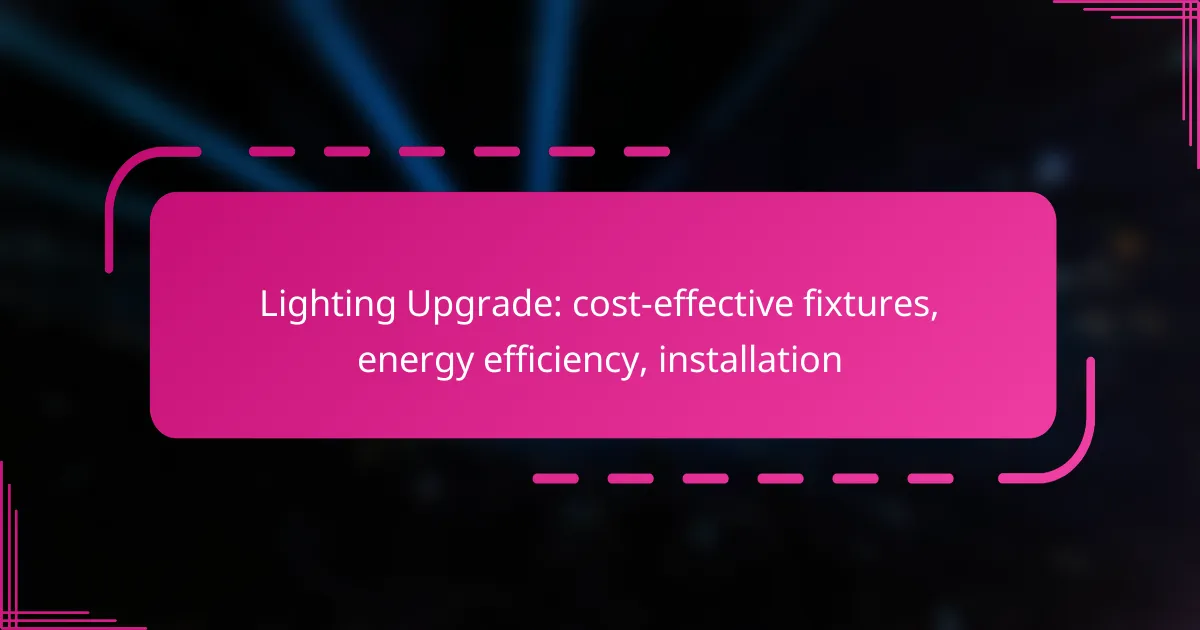Upgrading to cost-effective lighting fixtures can significantly enhance energy efficiency while reducing overall expenses. By selecting options like LED lights, you not only lower your electricity bills but also contribute to a more sustainable environment. Installation costs may vary based on factors such as labor and materials, but the long-term savings make it a worthwhile investment for both residential and commercial spaces.
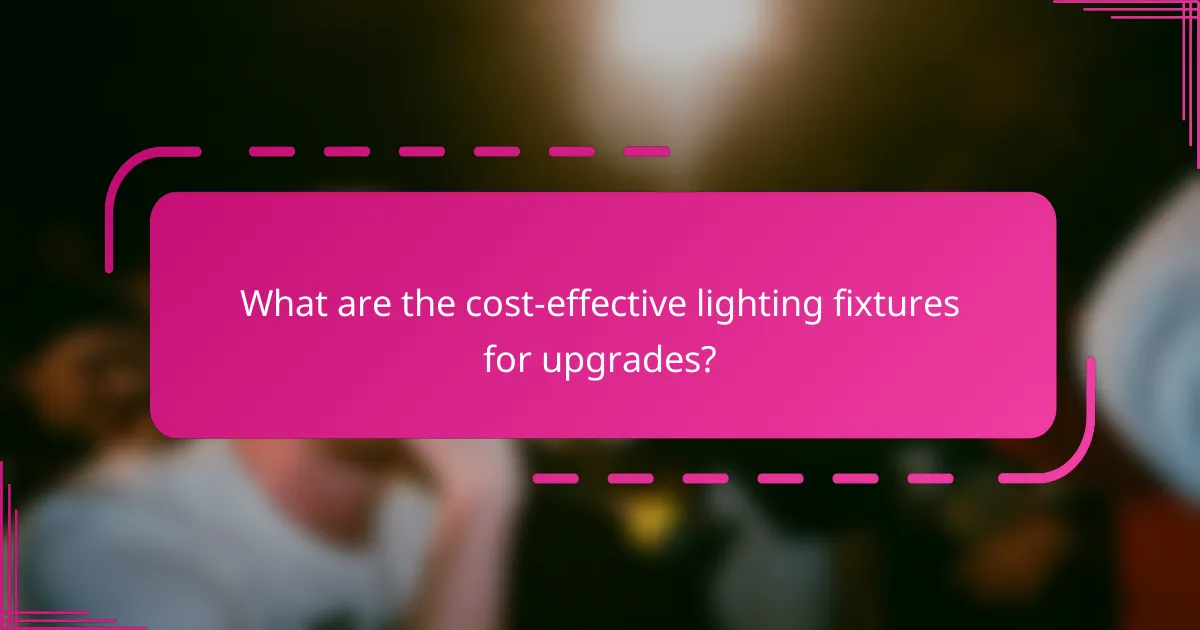
What are the cost-effective lighting fixtures for upgrades?
Cost-effective lighting fixtures for upgrades include options that enhance energy efficiency while reducing overall costs. These fixtures not only lower electricity bills but also provide long-lasting performance, making them ideal for residential and commercial spaces.
LED bulbs
LED bulbs are among the most cost-effective lighting fixtures available today. They consume significantly less energy compared to traditional incandescent bulbs, often using about 75% less electricity. Additionally, LED bulbs have a lifespan of up to 25,000 hours, which means fewer replacements and lower maintenance costs.
When selecting LED bulbs, consider the lumens per watt rating to ensure optimal brightness while maintaining energy efficiency. Look for Energy Star-rated products to guarantee quality and performance.
Smart lighting systems
Smart lighting systems offer both convenience and energy savings, making them a popular choice for upgrades. These systems allow users to control lighting remotely via smartphones or voice commands, enabling features like scheduling and dimming to reduce energy consumption.
Investing in smart lighting can lead to significant savings over time. For instance, using motion sensors can ensure lights are only on when needed, further enhancing energy efficiency.
Fluorescent fixtures
Fluorescent fixtures are a cost-effective option for larger spaces, such as offices and warehouses. They provide bright, even lighting and are more energy-efficient than incandescent bulbs, using about 25% to 35% less energy.
Consider using T5 or T8 fluorescent tubes, which offer better efficiency and longer life than older models. However, be aware that fluorescent fixtures may require more frequent replacement than LEDs, which could offset some savings.
Solar-powered lights
Solar-powered lights are an excellent choice for outdoor areas, providing illumination without increasing electricity costs. These fixtures harness solar energy during the day and use it to power LED lights at night, making them environmentally friendly and cost-effective.
When installing solar lights, ensure they are placed in areas with adequate sunlight exposure. While initial costs can vary, many homeowners find that the long-term savings on electricity bills make solar lights a worthwhile investment.
Compact fluorescent lamps (CFLs)
Compact fluorescent lamps (CFLs) are a popular alternative to incandescent bulbs, using about 70% less energy. They offer a longer lifespan, typically lasting around 10,000 hours, which reduces the frequency of replacements.
While CFLs are more efficient, they do contain a small amount of mercury, so proper disposal is essential. Look for ENERGY STAR-rated CFLs to ensure you are choosing high-quality, efficient options.
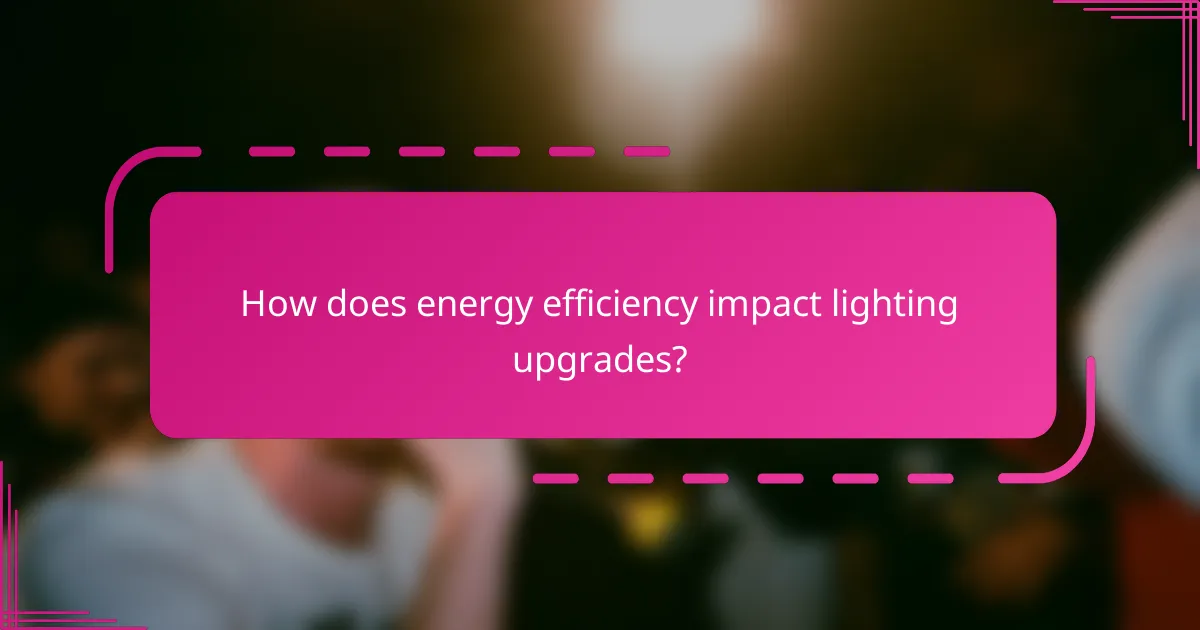
How does energy efficiency impact lighting upgrades?
Energy efficiency significantly reduces both operational costs and environmental impact when upgrading lighting fixtures. By choosing energy-efficient options, such as LED lights, you can lower energy consumption and benefit from long-term savings.
Reduced electricity bills
Upgrading to energy-efficient lighting can lead to substantial reductions in electricity bills. For instance, switching from traditional incandescent bulbs to LED fixtures can cut energy usage by up to 80%, resulting in savings that can reach hundreds of dollars annually for commercial spaces.
To maximize savings, consider installing smart lighting controls that adjust brightness based on occupancy or natural light levels. These systems can further decrease energy consumption and enhance cost-effectiveness.
Lower carbon footprint
Energy-efficient lighting contributes to a lower carbon footprint by reducing greenhouse gas emissions associated with electricity generation. For example, using LED lights instead of incandescent bulbs can significantly decrease the amount of energy needed, thus lowering the overall carbon emissions from power plants.
By opting for energy-efficient fixtures, businesses and homeowners can play a crucial role in environmental sustainability. Many regions offer incentives for adopting such technologies, making it an even more appealing choice.
Longer lifespan of fixtures
Energy-efficient fixtures typically have a longer lifespan compared to traditional lighting options. LED lights can last up to 25,000 hours or more, while incandescent bulbs may only last about 1,000 hours. This longevity reduces the frequency of replacements and associated labor costs.
When planning a lighting upgrade, consider the total cost of ownership, which includes initial purchase price, energy savings, and replacement frequency. Investing in longer-lasting fixtures can lead to greater savings over time, making them a smart choice for both residential and commercial applications.

What are the installation costs for lighting upgrades?
The installation costs for lighting upgrades can vary significantly based on factors such as labor rates, materials used, and whether you choose professional installation or a DIY approach. Typically, homeowners can expect to spend anywhere from a few hundred to several thousand dollars depending on the scope of the project.
Average labor costs
Labor costs for lighting installation generally range from $50 to $100 per hour, depending on your location and the complexity of the job. For straightforward installations, such as replacing fixtures, the total labor time may be just a couple of hours, while more complex upgrades could take a full day or more.
In urban areas, labor rates tend to be higher, so it’s wise to get multiple quotes from local electricians to ensure competitive pricing. Always check if the electrician is licensed and insured to avoid potential issues down the line.
Material costs breakdown
The material costs for lighting upgrades can vary widely based on the type of fixtures you choose. Basic LED fixtures may cost around $20 to $50 each, while designer or specialty fixtures can range from $100 to several hundred dollars.
In addition to fixtures, consider costs for wiring, switches, and any necessary hardware, which can add another $50 to $200 to your total. Always factor in potential costs for permits if required by local regulations.
Cost of professional vs DIY installation
Choosing between professional and DIY installation can significantly impact your overall costs. Hiring a professional may add $100 to $300 for labor, but ensures that the work is done safely and up to code.
On the other hand, if you have some electrical experience, DIY installation can save you money. However, be cautious—improper installation can lead to safety hazards and may void warranties on your fixtures. Always prioritize safety and consult a professional if you are unsure about any aspect of the installation process.
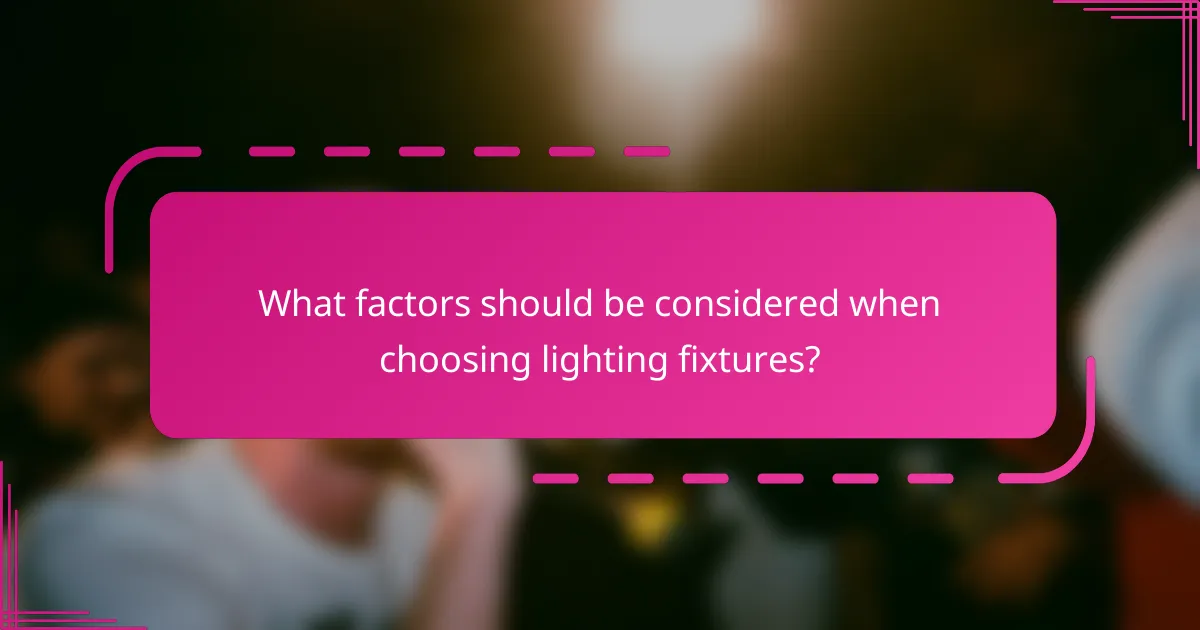
What factors should be considered when choosing lighting fixtures?
When selecting lighting fixtures, consider factors such as room size, fixture style, and compatibility with existing systems. These elements influence both the aesthetic and functional aspects of your lighting upgrade, ensuring optimal energy efficiency and cost-effectiveness.
Room size and layout
The size and layout of a room significantly affect the type of lighting fixtures you should choose. Larger spaces may require multiple fixtures or higher lumen output to achieve adequate illumination, while smaller rooms can often be well-lit with fewer, strategically placed lights.
Additionally, consider the room’s layout. For example, an open-plan area may benefit from fixtures that provide even light distribution, while a narrow hallway might need focused lighting. Measure the dimensions of your space to determine the best fixture size and placement.
Fixture style and design
Fixture style and design should complement the overall decor of your space. Choose fixtures that align with your interior design theme, whether it’s modern, traditional, or industrial. This enhances the visual appeal while providing functional lighting.
Consider the finish and materials of the fixtures as well. For instance, polished chrome or brushed nickel can add a contemporary touch, while wood or wrought iron may suit a rustic aesthetic. Ensure that the design also allows for effective light distribution.
Compatibility with existing systems
Before purchasing new lighting fixtures, check their compatibility with your existing electrical systems. Ensure that the fixtures can work with the current wiring and switches, especially if you are upgrading to energy-efficient options like LED lights.
Also, consider the type of bulbs required for the fixtures. Some may need specific wattages or types, such as dimmable options or smart bulbs. Review local electrical codes to ensure compliance and avoid potential safety issues during installation.
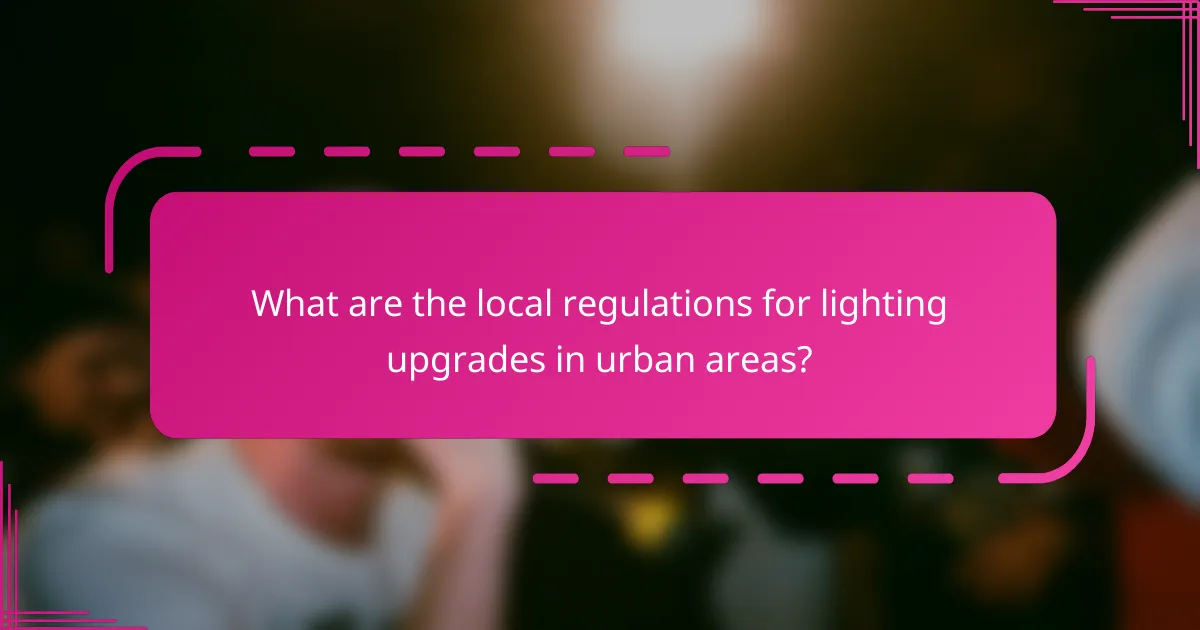
What are the local regulations for lighting upgrades in urban areas?
Local regulations for lighting upgrades in urban areas typically focus on safety, energy efficiency, and environmental impact. Compliance with these regulations is essential for ensuring that installations meet community standards and contribute to sustainable development.
Building codes compliance
Building codes dictate the minimum safety and performance standards for lighting fixtures in urban settings. These codes often cover aspects such as fixture placement, wiring methods, and the use of materials that reduce fire hazards. It’s crucial to consult local building authorities to ensure that your lighting upgrade adheres to these codes.
For example, many cities require that all new installations use fixtures that are rated for specific environmental conditions, such as moisture resistance in outdoor settings. Failing to comply can result in fines or the need for costly rework.
Energy efficiency standards
Energy efficiency standards are designed to promote the use of fixtures that consume less power while providing adequate illumination. Many urban areas follow guidelines set by national or regional energy authorities, which may include requirements for LED lighting or other energy-saving technologies.
When upgrading, consider fixtures that have an Energy Star rating or similar certifications. These products not only help reduce energy costs but may also qualify for rebates or incentives offered by local utilities.
Permitting requirements
Permitting is often necessary before undertaking a lighting upgrade, especially for significant changes or new installations. The permitting process ensures that the proposed work complies with local regulations and safety standards.
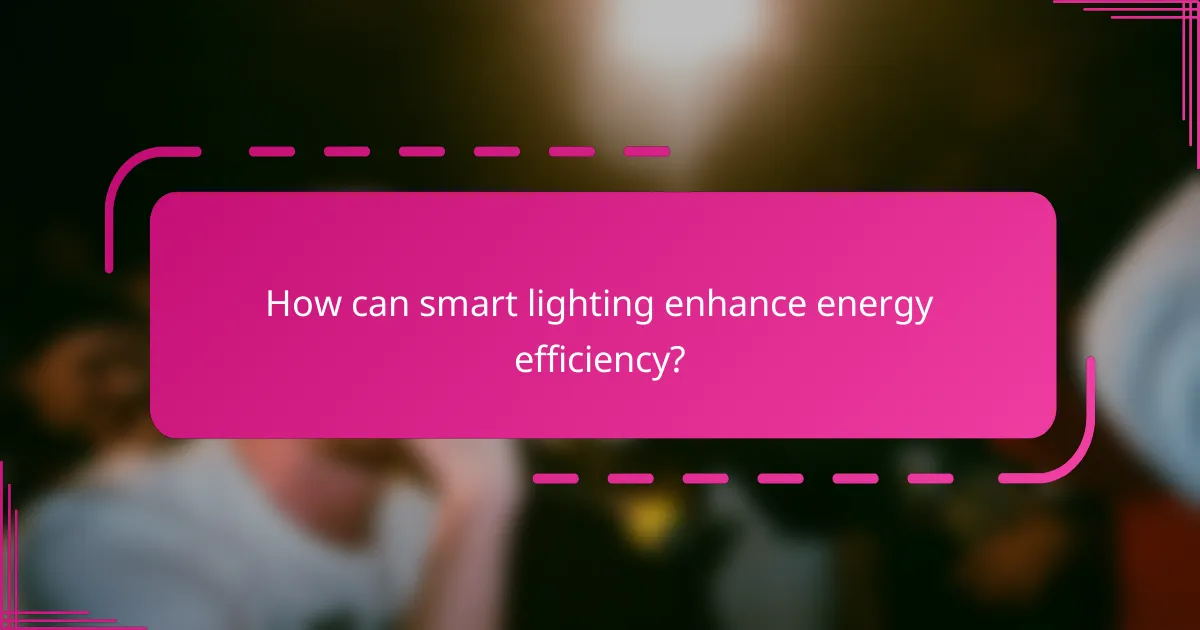
How can smart lighting enhance energy efficiency?
Smart lighting can significantly improve energy efficiency by utilizing advanced technologies to optimize usage and reduce waste. These systems adjust brightness and operation based on occupancy and natural light levels, leading to lower energy consumption and cost savings.
Automated scheduling
Automated scheduling allows smart lighting systems to turn on and off at predetermined times, ensuring lights are only active when needed. This feature can be programmed to align with daily routines, minimizing unnecessary energy use during off-hours.
For example, you can set outdoor lights to activate at sunset and deactivate at sunrise, or configure indoor lights to turn off automatically during work hours. This not only conserves energy but also extends the lifespan of the fixtures.
When implementing automated scheduling, consider the specific needs of your space. Avoid overly complex schedules that may lead to confusion; instead, aim for simple, intuitive settings that align with your lifestyle or business operations.
